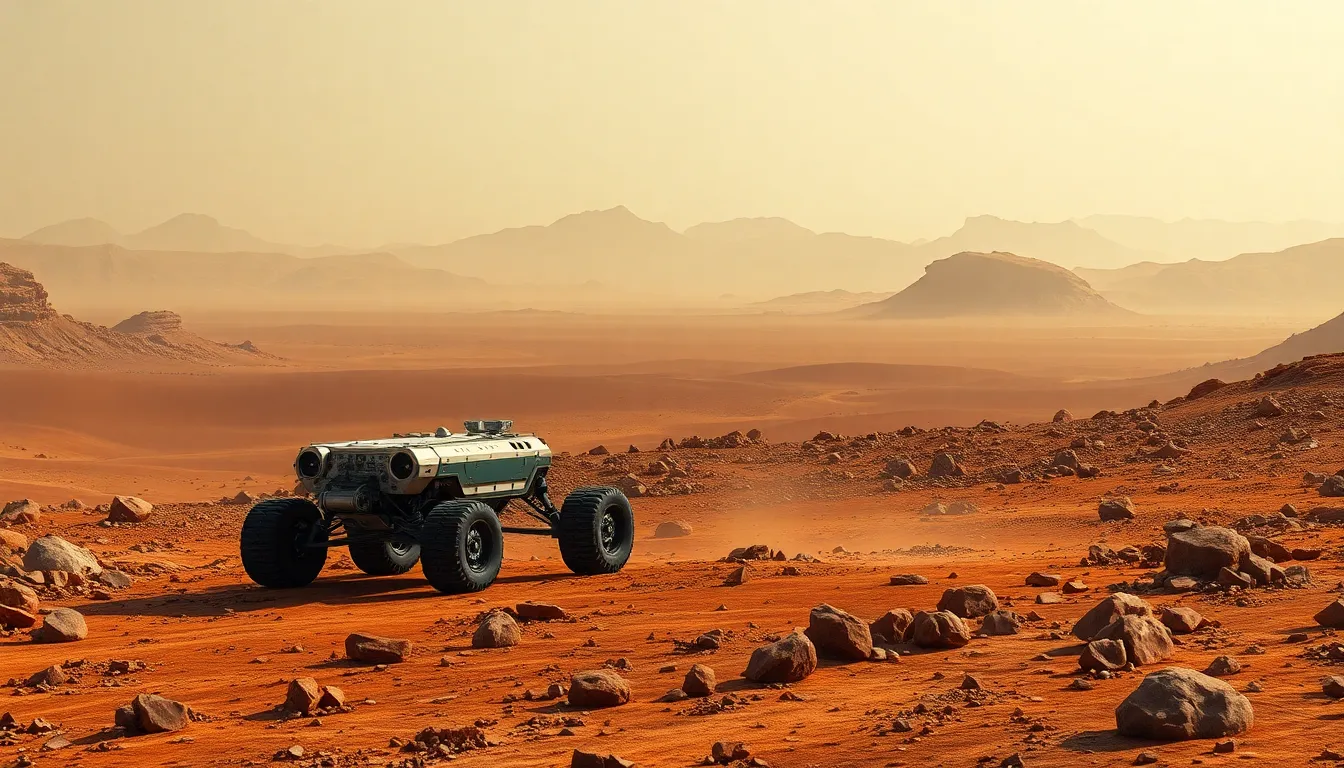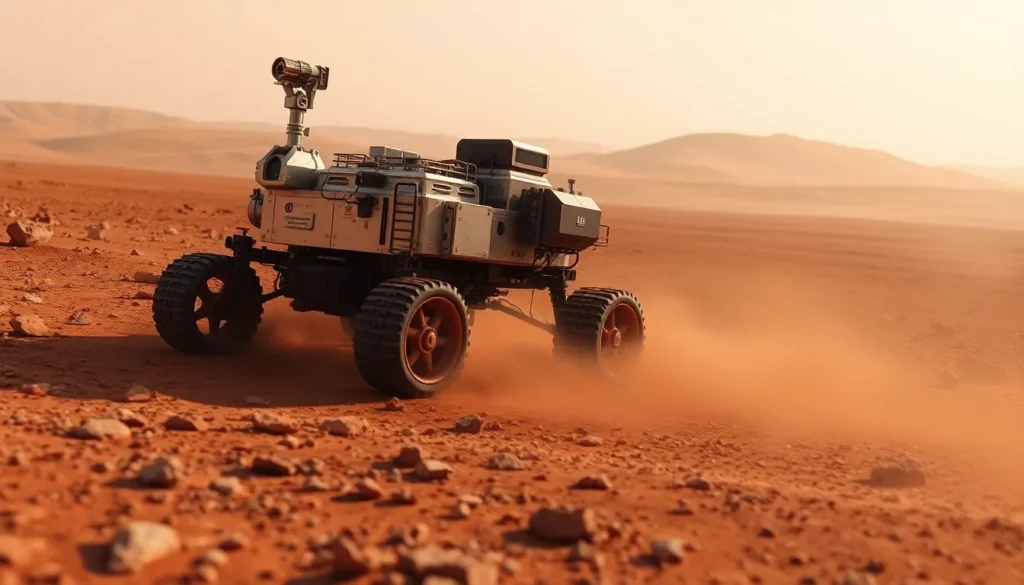Mars rovers have captivated the imagination of space enthusiasts and scientists alike, serving as humanity’s mechanical eyes on the Red Planet. These robotic explorers traverse the Martian landscape, gathering invaluable data that could unlock the secrets of our neighboring world. From the groundbreaking Sojourner to the more recent Perseverance, each rover has contributed significantly to our understanding of Mars’ geology, atmosphere, and potential for life.
As technology advances, the capabilities of these rovers continue to evolve, pushing the boundaries of exploration. Equipped with sophisticated instruments, they analyze soil samples, capture stunning images, and even search for signs of ancient life. The journey of these rovers not only enhances scientific knowledge but also inspires future generations to look toward the stars and consider the possibilities of life beyond Earth.
Table of Contents
ToggleOverview of Mars Rovers
Mars rovers are robotic vehicles designed to explore the surface of Mars, gathering vital data about its environment. These sophisticated machines play a crucial role in our understanding of the planet’s history, geology, and atmospheric conditions.
Key Mars Rovers
- Sojourner
Sojourner marked the beginning of Mars rover missions in 1997. It provided groundbreaking data about the Martian surface and demonstrated the feasibility of robotic exploration.
- Spirit and Opportunity
Spirit and Opportunity launched in 2003, each designed for 90 Martian days but operating for several years. They discovered evidence of past water activity, significantly advancing knowledge about Martian conditions.
- Curiosity
Curiosity, launched in 2011, is equipped with advanced analytical tools. It assesses Martian climate and geology while searching for organic compounds, enhancing the search for life.
- Perseverance
Perseverance, which landed in 2021, focuses on astrobiology and collecting rock samples for future return to Earth. It has the most advanced technology for analyzing Mars’ potential to support life.
Technological Innovations
Mars rovers incorporate cutting-edge technology to facilitate exploration. These include:
- Autonomous Navigation
Rovers utilize advanced algorithms for autonomous navigation, enabling them to traverse rugged terrains without direct human intervention.
- Scientific Instruments
Rovers carry a suite of scientific instruments, including spectrometers, cameras, and environmental sensors. These tools analyze soil samples and atmospheric conditions, providing invaluable data.
- Communication Systems
Rovers are equipped with robust communication systems that relay data back to Earth. This capability allows scientists to receive real-time or near-real-time information about Martian conditions.
Contributions to Science
The contributions of Mars rovers extend beyond immediate scientific findings. They enhance understanding of Mars’ potential for past life, inform future missions, and inspire public interest in space exploration. Each mission builds on the successes and lessons learned from previous rovers, paving the way for human exploration of Mars.
History of Mars Rovers

Mars rovers represent a significant evolution in space exploration. Each rover has contributed uniquely to understanding Mars, revealing its geology, climate, and potential for past life.
The Sojourner Rover
Launched in 1996 and landing in 1997, Sojourner became the first successful Mars rover. Weighing 11.5 kg, it operated for 83 days, exceeding expectations. Sojourner analyzed Martian rocks and soil, providing vital information and demonstrating the feasibility of mobile robotic exploration.
The Spirit and Opportunity Rovers
Spirit and Opportunity, twin rovers launched in 2003, expanded Mars exploration capabilities. Spirit operated until 2010, while Opportunity exceeded its expected lifespan, functioning until 2018. Each rover discovered evidence of past water, with Opportunity identifying hematite, a mineral indicating wet environments. Their findings revolutionized understanding of Mars’ habitability.
The Curiosity Rover
Launched in 2011, Curiosity features advanced technology, including a robust suite of scientific instruments and a car-sized design. Curiosity’s mission focuses on determining Mars’ past and present potential for life. It has analyzed soil samples, identified organic compounds, and measured atmospheric conditions, significantly enhancing knowledge of the planet’s climate and geology.
The Perseverance Rover
Perseverance, landing in 2021, aims to further astrobiology studies and sample collection for future return to Earth. With a suite of sophisticated tools, it examines rock samples and seeks signs of ancient microbial life. The rover also tests new technologies for future human missions, marking a pivotal step toward sustained exploration of Mars.
Key Features and Technology
Mars rovers are equipped with advanced technology that significantly enhances their exploratory capabilities. These features enable missions to gather vital data and assess the potential for life on Mars.
Scientific Instruments
Mars rovers utilize a variety of scientific instruments to analyze the Martian environment. Instruments include:
- Cameras: High-resolution cameras capture detailed images of the Martian surface, aiding in geological studies.
- Spectrometers: These devices analyze chemical compositions in soil and rocks, providing insights into mineralogy and potential past water presence.
- Weather stations: Equipped with sensors, these stations monitor atmospheric conditions, including temperature, wind speed, and dust levels.
- Radiation detectors: Instruments measure radiation levels on Mars, crucial for understanding the environment’s habitability.
Each rover incorporates customized scientific instruments tailored to its mission goals, enhancing the understanding of Mars’ geology and potential life-hosting conditions.
Navigation and Mobility
Mars rovers feature sophisticated navigation and mobility systems, allowing them to traverse the challenging Martian terrain. Key aspects include:
- Autonomous navigation: Utilizing onboard AI, rovers can analyze their surroundings and make real-time navigation decisions.
- Robust wheels: Designed for grip and durability, these wheels enable movement across rocky and sandy landscapes.
- Obstacle detection: Advanced sensors detect obstacles in the rover’s path, ensuring safe navigation and minimizing risks during exploration.
- Long-range mobility: Rovers can travel several kilometers over their mission duration, expanding their area of study significantly.
These navigation and mobility capabilities make Mars rovers vital for conducting extensive scientific investigations on the Red Planet.
Achievements and Discoveries
Mars rovers have made significant achievements and discoveries that enhance understanding of the Red Planet. Their contributions span across geology and signs of past life, providing critical insights into Mars’ history and potential habitability.
Geological Findings
Rovers like Opportunity and Curiosity have made extensive geological findings. Opportunity discovered hematite, a mineral often formed in water, indicating that liquid water existed on Mars’ surface. Curiosity has analyzed rock formations and sediment layers, revealing a diverse geological landscape shaped by volcanic activity and ancient water flows. It has also identified clay minerals, which require water for formation, further confirming the planet’s wetter past. These geological insights support the hypothesis that Mars underwent climate change, shifting from a warm, wet environment to the cold, arid landscape observed today.
Signs of Past Life
Rovers have provided compelling evidence for the possibility of past life on Mars. Curiosity’s analysis of the Gale Crater revealed organic molecules, complex carbon compounds essential for life. Perseverance, equipped with advanced instruments, focuses on astrobiology by exploring Jezero Crater, a site believed to have contained ancient lakes. The rover’s search for biosignatures aims to uncover relics of microbial life. These discoveries underscore Mars’ potential for hosting life forms, driving further exploration and research into its habitability and past ecosystems.
Future of Mars Rovers
Mars rovers continue to evolve, with plans for future missions aiming to enhance scientific discovery and pave the way for human exploration. Upcoming projects focus on advanced technologies and innovative research methodologies.
Upcoming Missions
NASA’s Artemis program and the European Space Agency’s ExoMars rover, slated for launch in 2022, represent significant steps in Mars exploration. ExoMars’ mission includes a rover equipped with a drill for subsurface sampling and an analytical lab to search for biosignatures. NASA’s Mars Sample Return mission, targeting the late 2020s, aims to collect and return samples collected by Perseverance, enhancing the understanding of Mars’ geology and potential past life. Other missions, such as those proposed by private companies like SpaceX, may involve rover technologies to support future human missions.
Potential for Human Exploration
Mars rovers serve as precursors to human exploration, providing crucial data on planetary conditions and resources. Research on Martian soil and atmospheric composition informs habitat development and survival strategies for future astronauts. Rover technologies, including life support systems and autonomous navigation capabilities, can be adapted for human use. As the rovers continue to unveil Mars’ secrets, they play a vital role in establishing sustainable practices for human presence on the Red Planet.
Mars rovers have transformed our understanding of the Red Planet and its potential for life. Each rover’s mission has provided invaluable data that shapes future exploration efforts. With advanced technologies and innovative designs, these robotic explorers pave the way for human presence on Mars.
The ongoing discoveries fuel excitement for upcoming missions, including the Mars Sample Return project and international collaborations. As exploration continues, the knowledge gained from rovers will be essential for establishing sustainable practices for future astronauts. The journey to uncover Mars’ mysteries is far from over, and the contributions of these rovers will play a crucial role in humanity’s quest to explore the cosmos.




